The Library Room is the large Farnese Hall. which dominates thenorth wing of the papal apartments.
The name is modern and was created to proximity to the Treasury Room, where for centuries the treasury and part of thePontifical Secret Archives. Here today read the history of papal power directly under a renaissance vault That looks like an open book.
The salon takes shape mid-sixteenth century in the revitalization program sought by Paul III Farnese after the Sack of Rome. The hall is attributed as an architectural design to Raphael of Montelupo (Michelangelo's collaborator), while the decorative building site is driven between 1544 e 1545 by Luzio Luzi of Todi, a student of Perin del Vaga. The result is a manifesto of the taste of grotesques In the Farnese age.
Look up: the vault is organized into five registers with Ten Stories of Ancient Rome at white background, framed by putties, candelabra e cameos. In the center camp the Farnese emblems, Virgin with unicorn e Lily of Justice, to reiterate the pontiff's dynastic message.
On eastern wall, above the big fireplace, two imposing allegorical figures, Rome and the Church, frame the papal coat of arms. On the short sides, the "guiding portraits." the emperor Hadrian e Archangel Michael, which hold together roman mausoleum e papal fortress.
Everything runs within a double frame: bottom 28 relief bezels with sacrifices e ancient deities alternating with the Farnese emblems; higher up a painted frieze by sea creatures interspersed with medallions.
The echo is explicit: the Domus Aurea newly rediscovered and the classical vocabulary that the Renaissance reinterpreted To celebrate Rome.
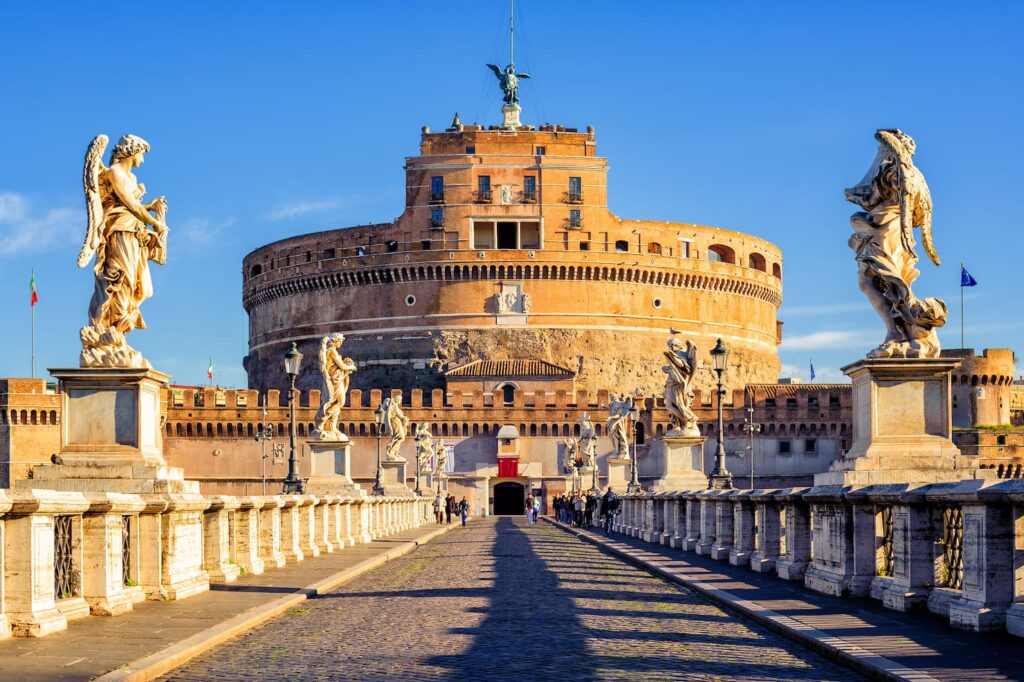
The best-selling ever
Castel Sant'Angelo: Entrance ticket + audio guide
Quick access and audioguide included: explore Castel Sant'Angelo and Roman Forum with one ticket.
Secure payment
Immediate confirmation
Cell phone ticket
- 1 The Library Room of Castel Sant'Angelo
- 2 Origins
- 3 Recent restorations and reopenings
- 4 What to see in the Library Room
- 5 The "satellite rooms": Adrianeo and Festoni
- 6 The nearby Treasury Room
- 7 Archivum Arcis: the documentary memory
- 8 The Round Room and Hidden Passages
- 9 Practical visiting tips
- 10 FAQ on the Castel Sant'Angelo Library
The Library Room of Castel Sant'Angelo
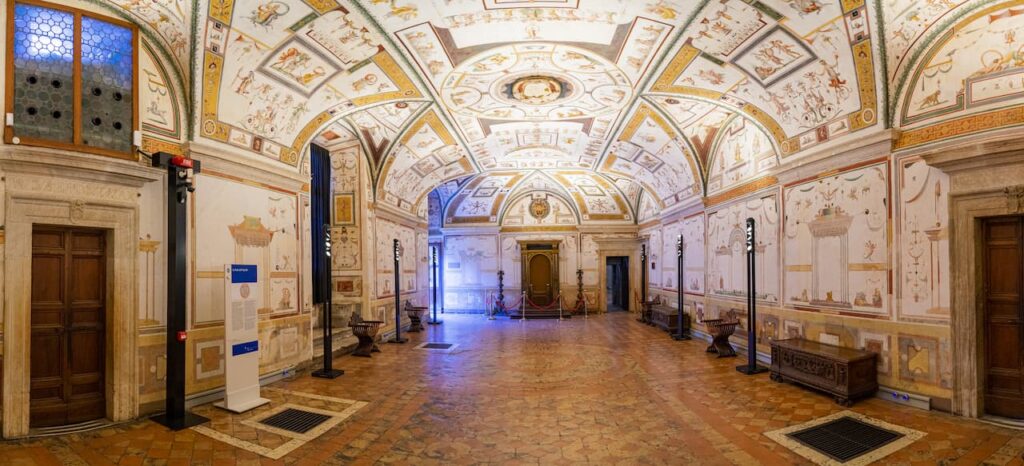
The Library Room is located in thenorth wing of the papal apartments and it is the fulcrum Of the Farnese route at the sixth level Of the castle. You are in the heart of the Renaissance itinerary dedicated to Paul III Farnese.
To get there follow the Pauline Hall and take the Pompeian Corridor: is the narrow frescoed passage which connects directly to the Library. You recognize it by the grotesque running on the walls and on the barrel vault. It is the easiest and most scenic way to enter the great hall.
Once inside, know that the Library acts as the joint For multiple environments. From here you access the Adrianean Hall and to the Hall of Festoons, two "satellite" rooms with sixteenth-century friezes signed Luzio Luzi. Immediately next door is the Treasure Hall, ancient seat of thetreasury and of thePontifical Secret Archives.
There is also a detail not to be missed: a narrow staircase of the Roman era leading to the Round Room, traditionally linked to the worship of St. Michael's. It is a vertical connection that tells well of the transition from the mausoleum at papal residence.
Origins
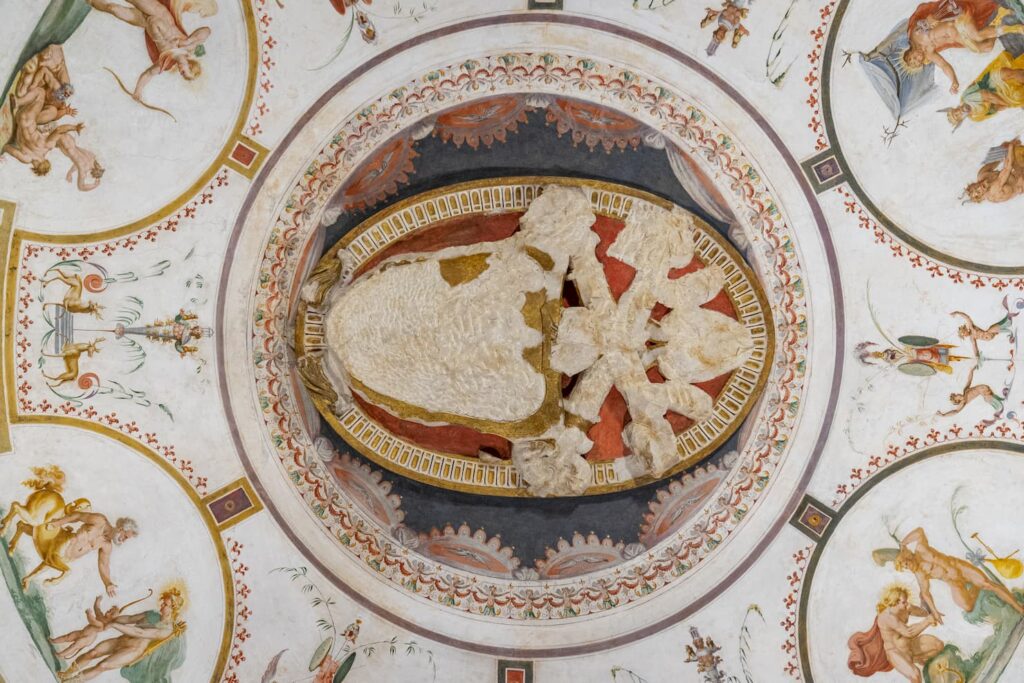
Patronage and transformations (15th-16th century)
At first the Library Room Was not a library. In Four hundred was the safest area near the Treasure Hall and guarded the treasury and part of thePontifical Secret Archives. The name "library" will come much later, to functional proximity to those deposits.
After the Sack of Rome in 1527, the castle changes its skin. Paul III Farnese transforms the ancient hall into a representative environment Of his northern apartment. Tradition attributes the architectural design to Raphael of Montelupo, Michelangelo's collaborator. It is a political and image choice: reorganizing the spaces of power and telling the Farnese rebirth.
The painting site is entrusted in the 1544-1545 a Luzio Luzi of Todi, a student of Perin del Vaga.
The construction site of Luzio Luzi (1544-1545)
Among 1544 and April 1545 Paul III Farnese entrusts the decoration of the hall to Luzio Luzi of Todi, which directs an articulate workshop of artists. The architecture of the great hall is attributed to Raphael of Montelupo, as part of the Farnese revival after the Sack of Rome. This is where the "Library" you see today was born.
Luzi sets up a unitary program fact of grotesques, stucco and fresco painting. The language looks to ancient Roman environments and in particular to the Hall of the Golden Vault of the Domus Aurea, a model that the artist absorbs and reinterprets. Not surprisingly, it was also called "Luzio Romano".
The vault is organized into five registers with Ten Stories of Ancient Rome at white background. Around them run two continuous friezes: bottom 28 relief bezels with sacrifices, deities and Farnese emblems; above, a frieze painting with sea creatures e stucco medallions. The facility is enhanced by black background cameos, medallions, candelabra e octagons with Victories. In the center shine the Farnese emblems (Virgin with unicorn e Lily of Justice).
The shipyard works at fast pace. Between conception, design and implementation, Luzi coordinates workshop and workers over vast areas, integrating stucco relief e painting to multiply effects of light and depth. The result is a hall-manifesto Of Farnese figurative culture, where visual archaeology e heraldry They become narratives of power.
Useful trivia: the room has been reopened to the public after the vault restoration, which restored brilliance to whites and reliefs. It is worth look up And taking their time.
Recent restorations and reopenings
In recent years the Library Room has returned to brilliance thanks to targeted interventions. In 2015 the 16th century frescoes have been restored with a construction site of four months financed for about 150,000: cleaning, consolidation and retouching have restored legibility to vault, putties e grotesque. It was a key step in restoring the hall to its best preserved condition.
After restoration, the hall was reopened to the public at the end of the work on the vault: an official communication emphasized precisely the reopening of the environment with its precious frescoes. If you look up today, the record drawing and the Farnese symbols turn out to be sharper.
Also contributing to the improvement in visiting conditions was a new lighting design: the Library and the Pauline Hall are usable with the new lighting, designed to enhance whites, reliefs and chromatics without glare. An upgrade that makes the details of cameos, candelabra e friezes.
The hall is today active also as space for cultural initiatives: falls within the calendar of the review "Under the Angel of Castle" and hosts shows and performances (e.g., the September 13, 2024 the Battle of Tancredi and Clorinda was presented just in the Library Room). This can result in. restricted access During the events.

The best-selling ever
Castel Sant'Angelo: Entrance ticket + audio guide
Quick access and audioguide included: explore Castel Sant'Angelo and Roman Forum with one ticket.
Secure payment
Immediate confirmation
Cell phone ticket
What to see in the Library Room
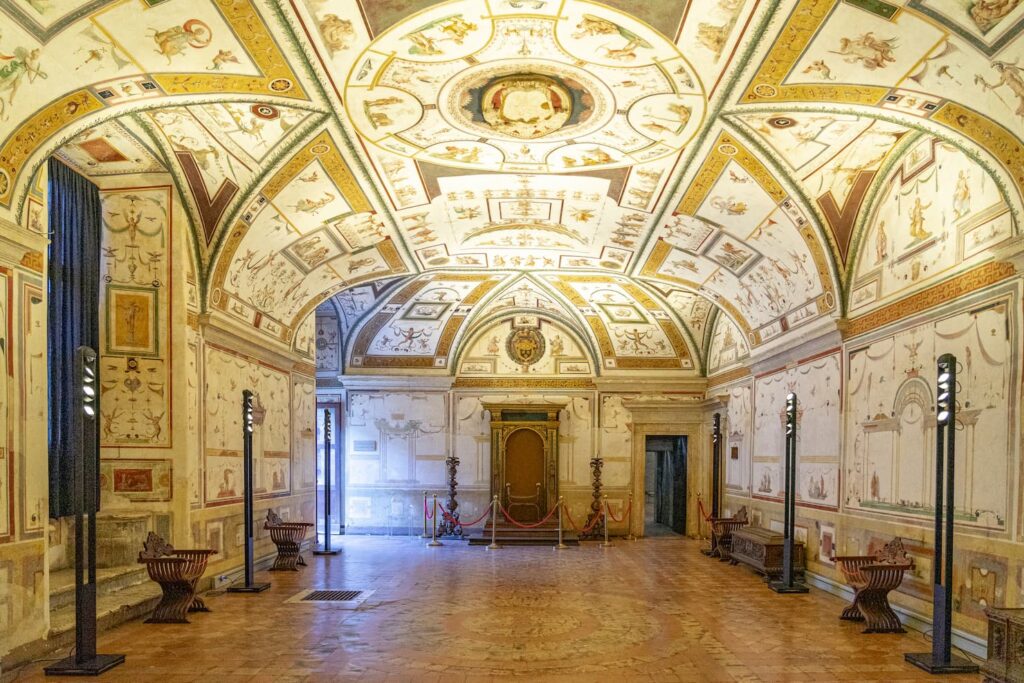
The vault: ten stories of ancient Rome
He looks up. The vault of the Library Room is a "theater" of grotesques: five concentric registers, ten Stories of Ancient Rome on white background, stucco and painting woven into a single figurative direction. The site was born between 1544 and 1545 with Luzio Luzi at the head of the Farnese workshop.
Framing the ceiling run two continuous friezes.
Bottom, 28 relief bezels tell sacrifices, ancient deities and Farnese emblems. Immediately above, a frieze painting with sea creatures is interrupted in the center of each wall with stucco medallions. The effect is a visual rhythm Guiding the eye inside the narrative.
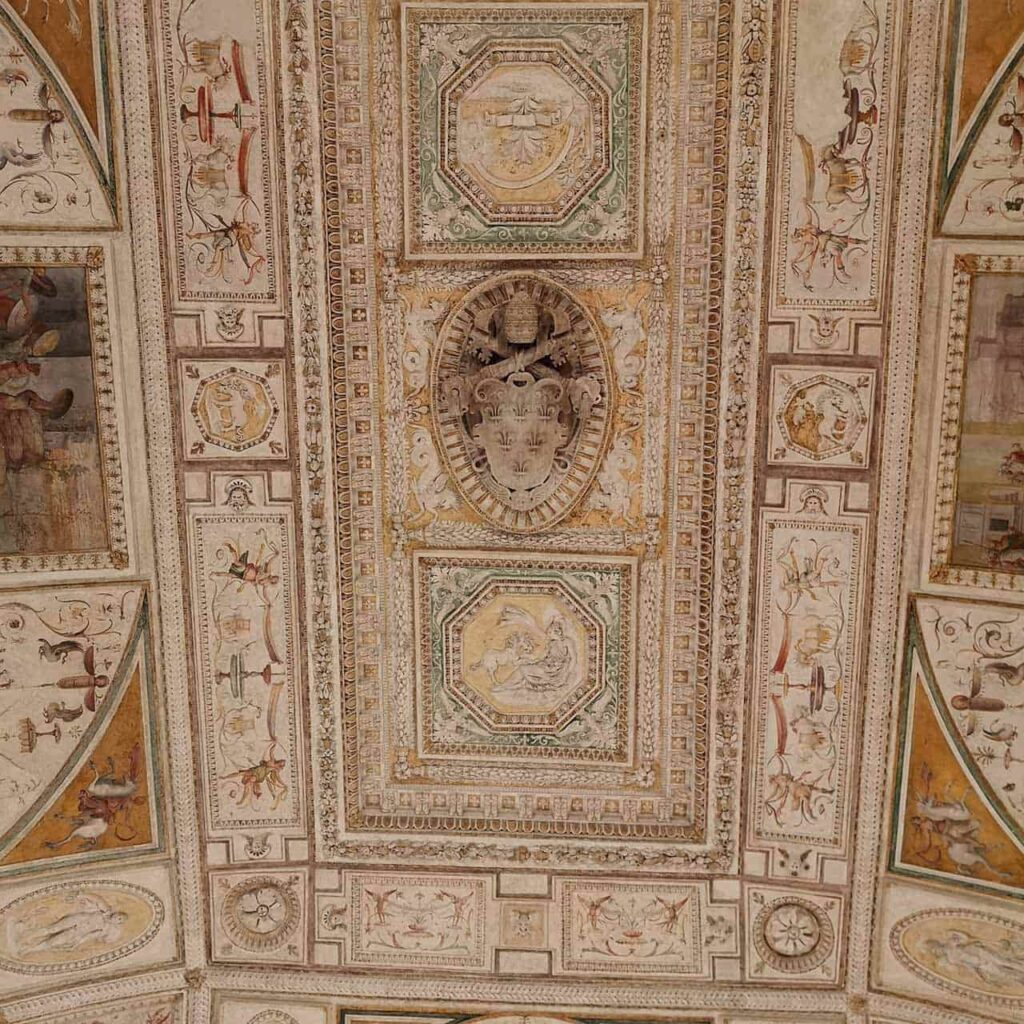
In the heart of the vault stand out the heraldic emblems: I Farnese coat of arms flanked by the Virgin with unicorn and from the Lily of Justice. They are the dynastic "seal" that makes . policy decoration, as well as spectacular.
At the ends, on the short sides, find the "guide" portraits: Saint Michael the Archangel and theEmperor Hadrian. On eastern wall, above the large fireplace, the allegories of Rome and of the Church framing the papal coat of arms. The program connects roman mausoleum e papal fortress into a single narrative.
The lexicon of grotesques looks to the ancient models of the Domus Aurea: streamers, candelabras, black background cameos, octagons with Victories, ovoli and medallions. For this ability to "speak ancient" with modern taste, Luzi is also remembered as a "Luzio Romano".
How best to read it? Positioned in the center of the room, follow the perimeter with the gaze to catch the double frieze, then go up toward the vault records and identifies the ten narrative frames. La reopening after vault restoration restored brightness to the whites and depth to the stucco: today the details are more legible and photographable.
Continuous stuccoes, grotesques and friezes
Here the decoration "speaks" in two bands running all around the room. Bottom recognize the stucco frieze with 28 lunettes: inside there are scenes of sacrifice, simulacra of ancient deities and Farnese emblems. The surfaces are alive, moved by light slipping over the reliefs.
Immediately above runs the second frieze, painting, all sea creatures in procession. At the center of each wall, the rhythm is interrupted to leave room for stucco medallions. It is a game of alternations designed to guide the gaze towards the vault.
To complete the apparatus, look at the "up close" details: Black background cameos with mythological deities, ovoli frames, other medallions and, in the angles, four large octagons with Victories e candelabra. They are the "talking ornaments" of the grotesque language which Luzio Luzi brings to Rome by updating the models of the Domus Aurea.
To read the whole thing well, stand in the middle of one long side. Follow the lower frieze to count the bezels and identifies the emblems of the Farnese. Then go back to the painted frieze and to the medallions, before looking up at the ten stories of ancient Rome. The effect is unitary: stucco and fresco respond to each other, the frame prepare the narrative.
Farnese symbols and heraldry
Here everything speaks Farnese. In the center of the vault towers the coat of arms of Paul III, flanked by two identity emblems: the Virgin with the unicorn and the Lily of Justice. It is the dynastic signature that transforms the hall into a political-artistic manifesto.
L'unicorn refers to the purity and to theintegrity of the Virgin, an image dear to Renaissance culture and to the same Farnese iconography; not surprisingly, it also recurs in family-related works. When you spot it in the vault, you are reading a sign of virtue and legitimacy Of papal power.
The Lily of Justice declares the government justice and belongs to the heraldic vocabulary of the Farnese. It is one of their historical emblems, also found in other rooms in the apartments, such as the Hall of Apollo, where he dialogues with the motto Festina Lente. In the Library you see it framed by the grotesque and from the cameos Of the vault.
On eastern wall, look at the big fireplace: on the sides, the allegories of Rome and the Church embrace the papal coat of arms. It is the key scene to understand the message of the hall: Ancient Rome + Church As a double root of power.
Closing the "heraldic frame" is the story to the short sides with the "guiding" portraits of Adriano e Saint Michael. The first recalls the imperial mausoleum from which the castle originates; the second is the protector that marks its Christian identity. They are the two faces that hold together ancient and sacred.
The monumental chimney
On eastern wall of the hall awaits you the big fireplace. Above, two imposing figures guide you in reading the room: the Church e Rome flank the papal coat of arms of Paul III. It is not just decoration. È the manifesto of Farnese power: spiritual authority and city identity supporting the papacy.
Watch it from half the hall, with the vault behind it. So you read the triad: allegories on the sides, coat of arms in the center. He then looks up at the vault to find the Farnese emblems echoing the heraldic message of the fireplace. Everything comes back, everything dialogues.
The fireplace is also a visual hinge of the route: connects the "classic" narrative of Stories of ancient Rome and of the grotesque friezes with the political self-portrait of Paul III. With the recent new lighting of the Library the group reads better, with sharper reliefs and outlines.
"Guide" portraits: Hadrian and St. Michael
The Library welcomes you with two symbolic faces. Sui short sides of the hall emerge the frescoed portraits of theEmperor Hadrian and of Saint Michael the Archangel. They are the key to reading the identity of the castle: roman mausoleum e papal stronghold In the same room.
Adriano It recalls the origin of the place. It is the founder of the mausoleum from which the entire complex was born. His portrait, today partly deteriorated, acts as a bridge to the Stories of ancient Rome Of the vault. Looking at it, keep in mind that everything here is about continuity with the empire.
St. Michael the Archangel is the protector which gives the castle its name. Tradition tells of the appearance of the 590 AD., when the archangel I will sheathe my sword to mark the end of the plague. It is the same gesture that you find in his iconography and culminates in the statue on the terrace. In the Library, his portrait "dialogues" with the papal coat of arms and with the fireplace Of allegories, welding faith e power.
To grasp them at their best, positioned in the middle of the room and looks first at one short side, then the other, leaving in the background the fireplace with Rome and the Church. The reading is immediate: Adriano is thesource, Michael is the protection.

The best-selling ever
Castel Sant'Angelo: Entrance ticket + audio guide
Quick access and audioguide included: explore Castel Sant'Angelo and Roman Forum with one ticket.
Secure payment
Immediate confirmation
Cell phone ticket
The "satellite rooms": Adrianeo and Festoni
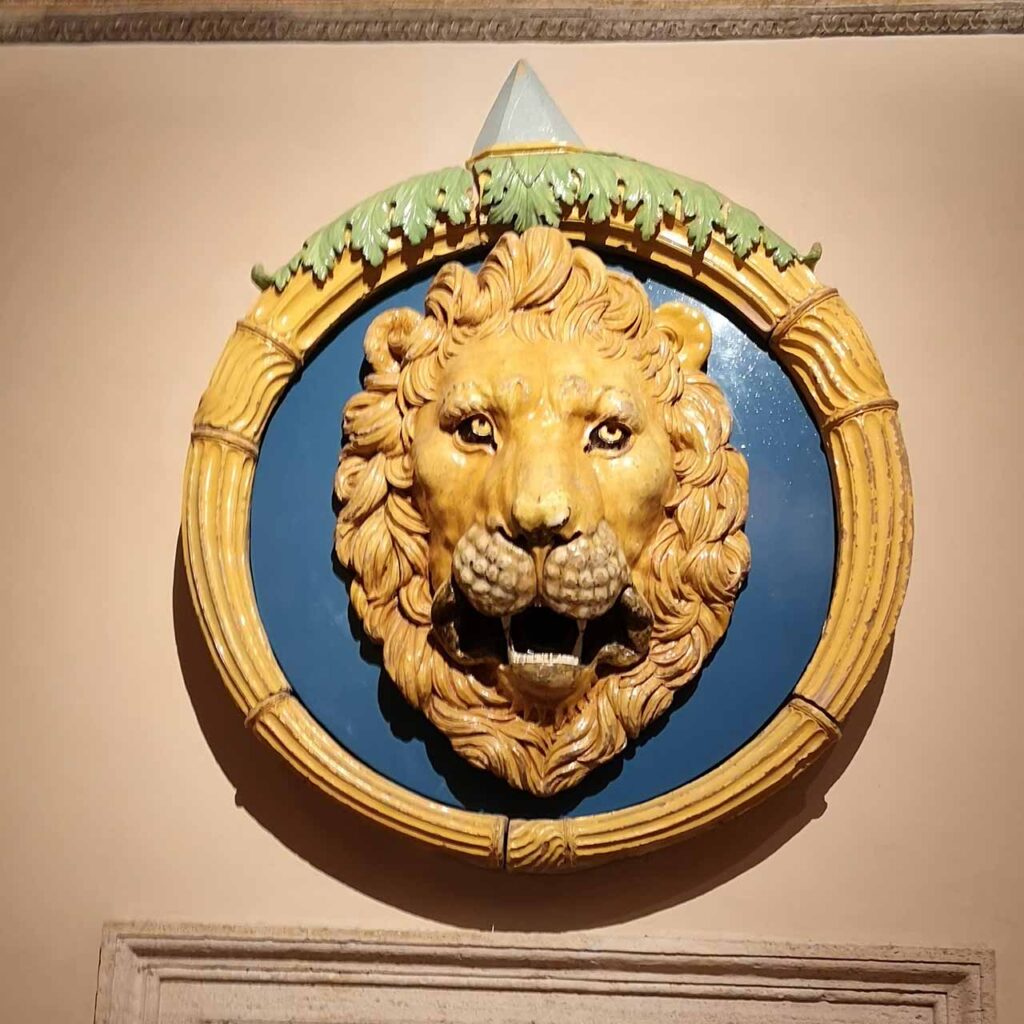
From Library Room you enter two adjoining dressing rooms born for Paul III and decorated in the 1544-1545 by Luzio Luzi With his team. They are smaller environments, but dense with details: they complement the reading of the Library and expand the narrative between mythology e Ancient Rome.
The Adrianean Hall is named after the paintings resurfaced in the 1902 restoration. At the top runs a continuous frieze with mythological scenes e satyrs, signed by Luzio Luzi. At center of each wall, inside a fake architecture, sprout views of ancient monuments: Naumachia of Domitian, Meta Romuli, Circus of Caligula and Nero, Mausoleum of Hadrian. In the eight side panels reappears the Dionysian world with deities, satyrs e maenads. It is the "guide" dressing room for understanding how the Renaissance translates . archaeology in decoration.
The Hall of Festoons owes its modern name to the summit frieze: processions of nereids and newts alternate with male and female figures and to unicorns, creating a wave motion continuous. The original ceilings are lost, but the ornamental direction by Luzio Luzi still reads just fine. Hence a playlist connects to the service rooms of the Courtyard of Alexander VI and to the Cagliostra. It is the passage that makes you perceive the network of rooms and passages Around the Library.
Practical advice: keep your gaze at the height of the frieze. In the Adrianean Hall first identifies the views of monuments and then back to the mythological scenes; in the Hall of Festoons follow the marine procession in full, until we find the Farnese unicorns. It therefore falls under Library and continue to the Treasure Hall or toward the Cagliostra, depending on your path.
The nearby Treasury Room
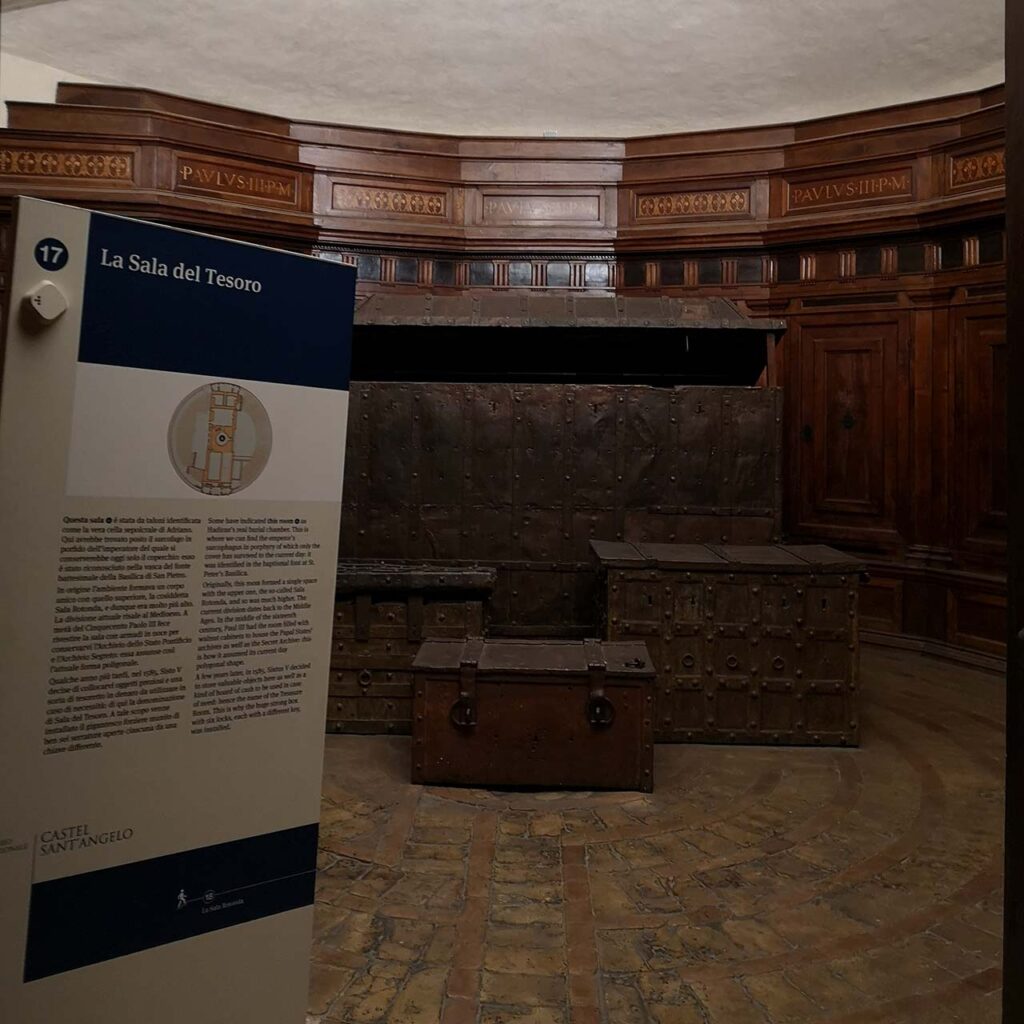
Next to the Library Room find the Treasure Hall. It is the armored heart of the castle: here they kept the treasury and the more confidential documents of Papal States. The room is circular and, from the 1545, had walnut cabinets attached to the masonry to preserve deeds, records and wealth.
At the end of the Four hundred here was attested a real golden reserve. In 1586 Sixtus V had the monumental iron caissons for theTreasury penalty, the treasury intended for the defense of the state. Imagine them still leaning against the walls, like a safe inside the safe.
L'access was extremely rigid. One entered from two doors. Le keys were in the hands of the Pope's Secret Treasurer and the Cardinal Dean. In the center, a huge chest guarded the money with six locks. A system designed to prevent tampering And ensure cross-checking.
The Treasury Room dialogues with the documentary memory of theArchivum Arcis. The papal funds preserved here were later transferred to theVatican Archives late eighteenth and early nineteenth centuries, after the events of the French domination. It is the piece that makes you understand why Castel Sant'Angelo was fortress, archive and bank.
A look at the internal topography helps you read the complex. Above the Treasury Hall opens the Round Room. You reach her from a narrow Roman staircase which starts from the Library. In modern times, this environment also served theexpansion of the Secret Archives, with wooden cabinets e iron gate.
Tip for visiting: stop at the entrance and rotate slowly On yourself. Note the circular plan, imagine the walnut cabinets along the perimeter and ideally locates the position of the iron caissons by Sixtus V. It is the easiest way to "see" thesafety engineering That once protected the treasure.
Archivum Arcis: the documentary memory
The Library Room is the threshold of the castle's archival system. Here began theArchivum Arcis, the documentary memory of the Papal States, developed between Treasure Hall, Round Room and then Hall of Columns. The name "library" originates precisely from the Proximity to the most protected repository Of the treasury and secret documents.
In Treasure Find the security footprint: walnut cabinets anchored to the walls (from the 1545), iron caissons wanted by Sixtus V for theTreasury penalty, double doors with separate keys and a six-lock chest. It is the very idea of the "archives-box."
With Clement VIII the Archives will expands vertically: from the Library a narrow Roman staircase leads to the Round Room, adapted to accommodate theexpansion of the Secret Archives with wooden cabinets e iron gate.
In the eighteenth century, theNew Archive: Benedict XIV sets up the Hall of Columns with furnishings for the archivists (walnut sideboards, tables, window guards). It is the building block that completes the "citadel of archives" around the Library.
The final chapter comes in the 1798: during the French occupation the funds of Castel Sant'Angelo are transferred to the Vatican along the Passetto di Borgo. Today they are part of theVatican Apostolic Archives (already Vatican Secret Archives).
The Round Room and Hidden Passages
Get up from the Library Room along a narrow staircase of the Roman era. It takes you to the Round Room, the space circular which originally stood above the Treasury Room forming a single volume. Tradition has it as first chapel dedicated to St. Michael. Today it is also home to temporary exhibitions.
Observe the walls. Clement VIII turned this room into a sector of the Secret Archives: wooden cabinets with metal locks ran around the perimeter. Access was protected by a iron gate. It is concrete evidence that here you guarded what really mattered.
In the center you will notice a rare detail: the original metal stand of the statue of Saint Michael by Peter Anton van Verschaffelt. Is that replaced during the restoration of the 1987. A technical fragment that tells the material life Of the monument.
I hidden passages Are the beauty of this area. La Roman staircase part from the Library and goes up here, creating a vertical connection between the Farnese Hall and the archival area. From the rooms next door, such as the Hall of Festoons, a service ladder descends toward the Courtyard of Alexander VI and the Cagliostra, the ancient prison of regard accessible right from the Library. It is a network of internal routes designed to move without being seen.
Insider tip. Stop at the entrance, rotates the gaze following the hall circle, then back to the scale: you will understand at a glance how archive, chapel and treasury dialogued in the same "secret core" of the castle.

The best-selling ever
Castel Sant'Angelo: Entrance ticket + audio guide
Quick access and audioguide included: explore Castel Sant'Angelo and Roman Forum with one ticket.
Secure payment
Immediate confirmation
Cell phone ticket
Practical visiting tips
The Library Room follows the museum hours.
Before we go, always check official updates: there may be extraordinary openings Or changes in the use of some rooms.
Good to know: the Library has been Reopened after vault restoration and is sometimes used for events; in those cases, access can be Contingent or limited to available seats. Check in advance communications and calendar.
For arrive to the Library, follow the Pauline Hall and take the Pompeian Corridor: is the narrow frescoed passage That connects directly to the hall. It is the most scenic And it gets you "straight" into the Farnese heart.
As read the room: come in and put yourself in the center. Follow with your eyes the two friezes running along the walls, then ascend to the five registers of vault with the Ten Stories of Ancient Rome. Look for the Farnese symbols in the center (the Virgin with unicorn and the Lily of Justice) and, on the short sides, Adriano e Saint Michael. Stop in front of the big fireplace with Rome and the Church: Here the heraldic message is crystal clear.
Itinerary smart Without going back:
- Library
- Adrianean Hall
- Hall of Festoons
- Treasure Hall.
If you want to extend your visit, from the Library you can go up along the narrow Roman staircase towards the Round Room.
Time and comfort: the area has stairs and transitions tight; arrange the visit with short breaks In the center of the hall and near the fireplace. Always respect on-site directions On behaviors and photos.
FAQ on the Castel Sant'Angelo Library
It is the grand farnesian hall of thenorth wing of the apartments of Paul III. Today you recognize her by the grotesque vault with Ten Stories of Ancient Rome, putties e Farnese emblems. The name "library" comes from the proximity to the Treasury Room, where they kept treasury e documents.
Follow the Pauline Hall and take the narrow Pompeian Corridor: connects directly to the Library Room. It is the most scenic passage to enter the hall.
The cycle is of Luzio Luzi With workshop, 1544-April 1545. The hall is the fulcrum of the wing of Paul III Farnese.
Five registers at white background with ten stories of ancient Rome, framed by two continuous friezes: bottom 28 stucco bezels with sacrifices and gods, above sea creatures e medallions. Middle, Virgin with unicorn e Lily of Justice.
Yes, it falls under the museum route. Always consult the official updates On schedules. The hall has been reopened after the vault restoration. Book To optimize entry time.
The Library Is part of the standard itinerary of the museum, along with Treasure Hall, Adrianeo e Streamers. Find visit options On the tickets page.
Reopened to the public upon completion of vault restoration. The intervention restored legibility to frescoes and stuccoes.
To get there you go through the narrow Pompeian Corridor. From the Library also starts a narrow staircase of the Roman era towards the Round Room. If you have specific needs, check in advance the conditions of access.
Usually Are allowed for personal use without flash, but the on-site directions prevail and may vary during events. Check on site and respect museum rules.
The Treasure Hall Is the "safe" of the Papal States: walnut cabinets (from the 1545), iron caissons by Sixtus V e six-lock chest. From here develops theArchivum Arcis which in 1798 was transferred to the Vatican along the Passetto di Borgo.
Enter Library, switch to the Adrianean Hall, then Hall of Festoons, then Treasure Hall. It is the most fluid Without going back.
Pupil of Perin del Vaga, brings to Rome a grotesque lexicon inspired by the Domus Aurea. In the Library he coordinates the shipyard and signs thedecorative planting you see today.